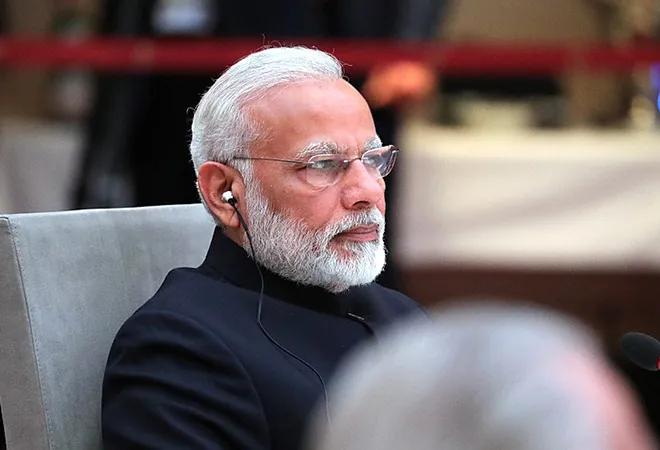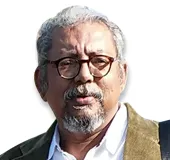-
CENTRES
Progammes & Centres
Location
Modi has got rid of underachievers and brought in the best of the talent at his disposal to mind infrastructure, agriculture, energy and railways, apart from MSMEs

India has a new Government and it reflects the authority that now vests with Prime Minister Narendra Modi after his spectacular victory in the general election. Unlike in 2014 when he was catapulted to the Prime Minister’s office — a candidate who came in from the cold and took Lutyens’s Delhi by storm — and had to tread gingerly, at least during the first couple of years, this time he begins his five-year term as a leader who is not only absolutely powerful but also at ease with the unquestioned and uncontested power he wields.
A post-election commentary described his transformation from ‘Modi Ji’ into ‘Modi Xi’, the singularly strong leader India craved for after experiencing the decisiveness of Modi 1.0. Simply put, if the previous Government was that of Modi Ji, the new Government is that of Modi Xi — raring to fetch India its rightful place in the global order through economic growth and equitable development, order at home and engagement abroad. The people who voted for Modi expected a potentially pugilist government; Modi Xi has delivered one.
At one level, the disruptive changes that have been brought about can be described as predictable given Modi’s track record of occasional disruption, causing unprecedented upheaval in India’s lethargic ‘system’ of governance. At another level, the disruptive changes are in keeping with the aspirations of a ‘new’ India that has little patience for the old-fashioned charms of the Vienna Congress (described by a senior BJP leader as “dancing, dancing but not advancing”) and would rather see government playing a high-stakes, risk-prone game.
Modi Ji the astute politician would have no doubt hedged his risks while selecting his team but the fact that Modi Xi has opted for a radically restructured government, at least in terms of ministerial selection and portfolio allocation, suggests that he means business twice over and more in his second consecutive term as Prime Minister.
King Charles II had his ‘cabal’ which would meet in a ‘cabinet’, a wood-paneled anteroom through whose thick walls not a word whispered inside would travel through, advising him on high affairs of state. India’s prime ministers have had their cabals and cabinets but history tells us that while few had the authority or freedom to choose who would be their Clifford, Arlington, Buckingham, Ashley and Lauderdale, the cabinets they occupied had papier mache walls through which not only words but entire documents would effortlessly seep through. Mrs Indira Gandhi was known as “the only man in her cabinet” but even she had to accommodate ginger groups and factions in the Congress that accepted her leadership as the glue that held them together and not because they bowed to her undisputed supremacy.
In NDA2 Prime Minister Modi was primus inter pares; the first among equals. In NDA3 he is the Supreme Leader, the one who decides who get to sit in his Cabinet regardless of how others feel. It was speculated that Finance Minister Arun Jaitley’s exit due to reasons of health would leave a gaping hole. The surprising exclusion of Foreign Minister Sushma Swaraj was to have made that hole bigger, almost unpluggable.
But Modi has demonstrated that challenges can be converted into opportunities and that this is not merely a cliché. By bringing in former Foreign Secretary S. Jaishankar as his Minister for External Affairs he has shown enormous dexterity for a politician whose natural inclination would have been to have a fellow politician, preferably a loyalist, in South Block, toeing the line, though even that had become doubtful during the UPA decade.
It’s not that the Foreign Ministry has not had a Minister from the foreign service in the past. K. Natwar Singh, a career diplomat, returned to head the Ministry though after a considerable period of time after his exit. Natwar Singh had to become a party insider, a palace courtier, before being offered the job. The routine was the same for others from the IFS who went on to hold public office. Not so Jaishankar, a rank ‘outsider’ who came in on the strength of merit. While it is true that he will have to join the BJP because he will be governed by the party whip in Parliament, the fact remains it was not a condition precedent prior to his induction.
But those were different times when vacuity would masquerade as policy. India now faces immediate and looming geopolitical and geostrategic challenges in a world of rapidly shifting and transient alignments. If Modi is going to push for a stronger, more meaningful BIMSTEC coupled with a SAARC minus Pakistan, it will require out-of-the-box thinking, as will dealing with an increasingly belligerent America spoiling for trade wars. India’s engagement with China has to be more nuanced, balancing the national interest with China’s quest for global (and regional) dominance. India has to reinvent its relationship with Russia, bridging gaps and creating commonalities.
Jaishankar brings with him the experience of dealing with both the US and China and, as Foreign Secretary, demonstrated his ability to effortlessly fuse his remarkable diplomatic skills with Modi’s policy imperatives. Unencumbered by compulsions of politics, Modi chose him for his professional abilities and to signal that delivery matters the most in this penultimate term of his prime ministership, presuming he would be in the race again in 2024.
While Pakistan will be made to sit in the proverbial corner and await Modi’s attention for the moment, a medium term policy would have to be put into place to deal with India’s recalcitrant western neighbour. This would invariably be tied to how Modi decides to deal with the festering issue of rancid politics in and over Jammu & Kashmir. If Home Minister Amit Shah is able to restore even a semblance of peace and political stability, backed by Defence Minister Rajnath Singh (whose experience in the Ministry of Home Affairs and near success in eliminating the Maoist menace will stand him in good stead), the Prime Minister and his Foreign Minister would have greater leeway in dealing with Pakistan.
Admittedly, Singh and Shah are as different as apples and oranges in their style and approach. But it is this combination of South Block and North Block which opens up immense possibilities in recrafting internal and external security policies and architectures that are more in tune with the times and the challenges ahead.
One of the aspiration points that Modi has been highlighting is to push the $3 trillion Indian economy towards the $5 trillion mark by 2025. That would be possible only if the economy were to do exceptionally well at home and foreign commerce and trade were to gather speed. Neither is happening at the moment. Nirmala Sitharaman has come in as the first woman Finance Minister after a successful stint in corporate affairs, trade and defence. She is no novice and is in tune with the political goals of the Prime Minister — growth, jobs and development.
Contrary to popular perception, the finance ministry needs political leadership more than a politician playing economist, guiding the political economy towards what the party in power believes is the desirable goal. On commerce and trade we can envisage a vigorous effort by Piyush Goyal on the policy front with Hardip Singh Puri driving a hard bargain at trade talks, bringing to the table his previously demonstrated expertise. If this were to be dovetailed with the efforts of the foreign and finance ministries, winning the game won’t be an option.
If one were to look at all the economic affairs ministries in totality, we would find that Modi has got rid of underachievers and brought in the best of the talent at his disposal to mind infrastructure, agriculture, energy and railways, apart from MSMEs. Nitin Gadkari the doer remains in charge of roads and highways, and will also nurse MSMES back to health. By creating a new water ministry, Jal Shakti, he has initiated the process of integrating water management into the national grid of development and security. If Swachh Bharat was NDA2’s signal programme, water management, including potable water for the masses, could become the flagship scheme of NDA3, providing a boost to both public health and farm income. Ravi Shankar Prasad, Piyush Goyal and Dharmendra Pradhan among themselves, and with others, including Hardip Singh Puri, will be anchoring continuity in the flux of change initiated by Modi.
A week after India gave a resounding ‘Mandate Modi’, the Prime Minister has given India a ‘Team Modi’ high on adrenaline. The ideas will be largely his, the execution of those ideas will be the remit of his carefully selected team. The top five, Rajnath Singh, Amit Shah, Nirmala Sitharaman, S. Jaishankar and Nitin Gadkari — Modi Ji’s Clifford, Arlington, Buckingham, Ashley and Lauderdale — could help Modi Xi transform India over the next five years in ways never imagined before.
But then, who could have imagined that JNU would one day contribute two of the five stars of an aggressively, unapologetically nationalist government, implementing, if not guiding, right-of-centre economic and foreign policies? Which leads us to the question, would this radical shift in Cabinet formation that has made conventional wisdom stand on its head have been possible without Modi’s transformation through a popular mandate from Modi Ji to Modi Xi?
The views expressed above belong to the author(s). ORF research and analyses now available on Telegram! Click here to access our curated content — blogs, longforms and interviews.

Kanchan Gupta was a Distinguished Fellow at ORF. His work focuses on Indias political economy. His areas of interest are domestic politics and the Middle ...
Read More +